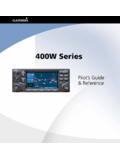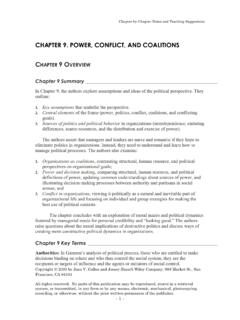Transcription of All Bottled up: The Perfect Ecosystem
1 Science Enhanced Scope and Sequence Grade 1 virginia department of education 2012 1 Seasonal Changes Strand Earth Patterns, Cycles, and Change Topic Investigating the effect of seasonal changes on plants and animals Primary SOL The student will investigate and understand weather and seasonal changes. Key concepts include a) changes in temperature, light, and precipitation affect plants and animals, including humans. Related SOL The student will demonstrate an understanding of scientific reasoning, logic, and the nature of science by planning and conducting investigations in which b) observations are made from multiple positions to achieve a variety of perspectives and are repeated to ensure accuracy; c) objects or events are classified and arranged according to characteristics or properties; f) inferences are made and conclusions are drawn about familiar objects and events; h) predictions are made based on patterns of observations; i) observations and data are recorded, analyzed, and communicated orally and with simple graphs, pictures, written statements, and numbers.
2 Background Information Lower daily temperatures and fewer hours of daylight cause some plants to go into a dormant state and cause some animals to migrate, hibernate, and/or grow thicker fur. As daily temperatures and hours of daylight increase, plants come out of their dormant state, animals in hibernation wake up, and animals that migrated return. Materials Large four-square graph to place on floor Large season labels (Autumn, Winter, Spring, Summer) for the squares Posters depicting the four seasons (optional) Large bag or box containing identifiable seasonal items ( , gloves, sandals, sweater, umbrella, pictures of animals and plants in various seasons) at least one for each student 12 x 18 inch white construction paper, one sheet for each student Scissors Paste Trees in the Seasons handout (attached) Small pictures of plants and animals in the four seasons and of people in seasonal dress Vocabulary autumn (fall)
3 , dormant, hibernation, migration, precipitation, seasonal changes, spring, summer, winter Science Enhanced Scope and Sequence Grade 1 virginia department of education 2012 2 Student/Teacher Actions (what students and teachers should be doing to facilitate learning) Introduction 1. Call students to the group meeting place around the four-square floor graph. 2. Review the names of the seasons, using large labels on the graph. Also use posters of the four seasons, if available. 3. Let each student pull a seasonal item from the bag or box, think about the season the item matches, and place it in the appropriate season square. Have students share why the items match the identified seasons.
4 Point out that some items may overlap two seasons. Be accepting of reasonable answers, and lead students who need some guidance. Procedure 1. Refer to the representations of each season that students placed on the floor graph. Ask: What type of clothing would you want to wear if it is very hot outside? What type of clothing would you want to wear if it is warm outside? Which seasons are usually warm or hot? Which are usually cool or cold? Have students share how their clothing and behaviors change when the weather turns hot and when it turns cold. How does the weather in each season affect your activities? 2. Show pictures of animals in the four seasons, and have students discuss what they notice.
5 Do some animals, such as frogs, appear only in one season but not in others? If so, what may be some reasons that these animals are seen only in certain seasons? 3. Explain what it means to hibernate and what it means to migrate. Do you notice some animals hibernating or migrating? Can you name some other animals that may do the same things? 4. Ask students to look at the plants and trees in the pictures of each season. How are they alike? How are they different? Are there some that can grow only in certain seasons? Are there any that look the same in all seasons? 5. Sum up how the seasons with their different temperatures affect the plants and animals seen in the pictures. Tell students that the seasons also affect the weather, and have them identify the different types of weather they see in the pictures.
6 6. Leave the pictures on the floor graph for reference, or display them on the wall. 7. To review, read aloud a story about the seasons and/or seasonal information from the Internet. Trees in the Seasons Lift-a-Flap Activity 1. Give each student a sheet of 12 x 18 white construction paper, a pair of scissors, paste, a copy of the attached Trees in the Seasons handout, and various small seasonal pictures. 2. Show students how to fold the sheet of paper in half the long way, carefully lining up the corners. Then, show them how to fold it carefully in half twice more and then unfold the last two folds to reveal four equal sections, as shown at right. Science Enhanced Scope and Sequence Grade 1 virginia department of education 2012 3 3.
7 Direct students to turn the folded sheet so that the fold is at the top. Show them how to make three cuts along the creases only in the upper flap from the bottom edge up to the long fold to create four liftable flaps. Caution them not to cut the lower flap. 4. Have students cut apart the four tree pictures and the four season names on the handout. 5. Direct students to paste each tree on a flap and paste the matching name under the flap. Check matching of pictures and names before students paste them down. 6. Around each name, have students paste pictures of people dressed for that season and plants and animals in that season. Monitor matching of pictures and seasons. 7. Have students lift each flap and tell about that season, using the name and pictures on the inside.
8 8. Show students how to use their Lift-a-Flap for review by predicting each season based on the tree on the outside and then lifting the flap to show the name and pictures of that season. Assessment Questions o How do seasonal changes affect the behavior of animals, including people? o How do plants change from season to season? Journal/Writing Prompts o In your science journal, tell the season you enjoy the most. Explain why it is your favorite, and tell specific things that happen in that season that make you like it best. Add a picture of you enjoying that season. o Pick an animal that migrates or hibernates. Write about what it would be like to be this animal for a season, and tell some of your experiences.
9 Other o Match seasonal pictures to one of the four seasons on a cut-and-paste or computer-generated activity. o Create a report on your favorite season. Present it to the class in a way that shows how the animals, plants, and people act during this season. Extensions and Connections (for all students) Choose a tree or other plant on the school grounds that shows seasonal changes. Have students work together to keep a class notebook about the changes in the plant that they observe throughout the school year. Students may take turns writing the class s observations. Include a digital photo reference for each season, if possible. Have students perform an experiment to force a flowering plant, such as branch of forsythia, to bloom.
10 Have them explore the scientific process involved and monitor the length of time it takes. Review the needs and parts of a plant during the process. Have students explore some severe weather conditions, such as drought, flood, or high wind, and how these conditions may have a devastating effect on plants, animals, and people. Have them include ways an area affected by such conditions adapted. Science Enhanced Scope and Sequence Grade 1 virginia department of education 2012 4 Strategies for Differentiation Use an interactive board to provide a visual display of pictures for each season. If an audio component is available, have students listen to spoken descriptions of the pictures, thus making them more familiar with the vocabulary of the lesson.














